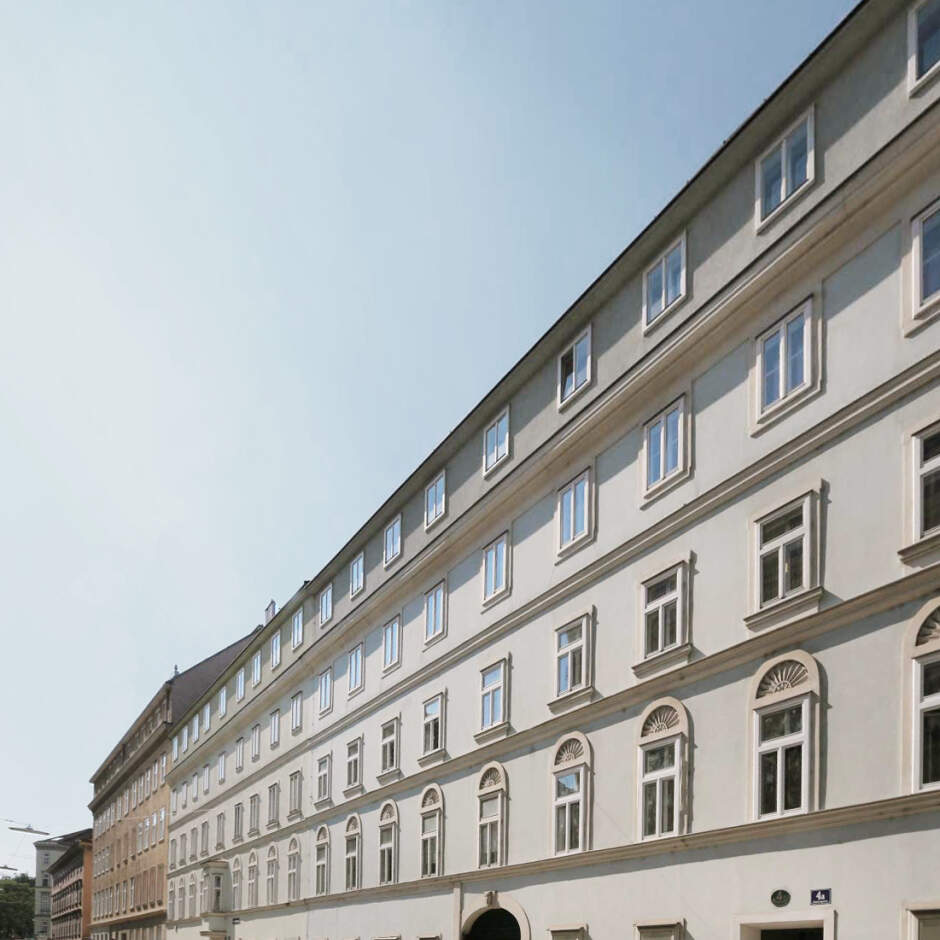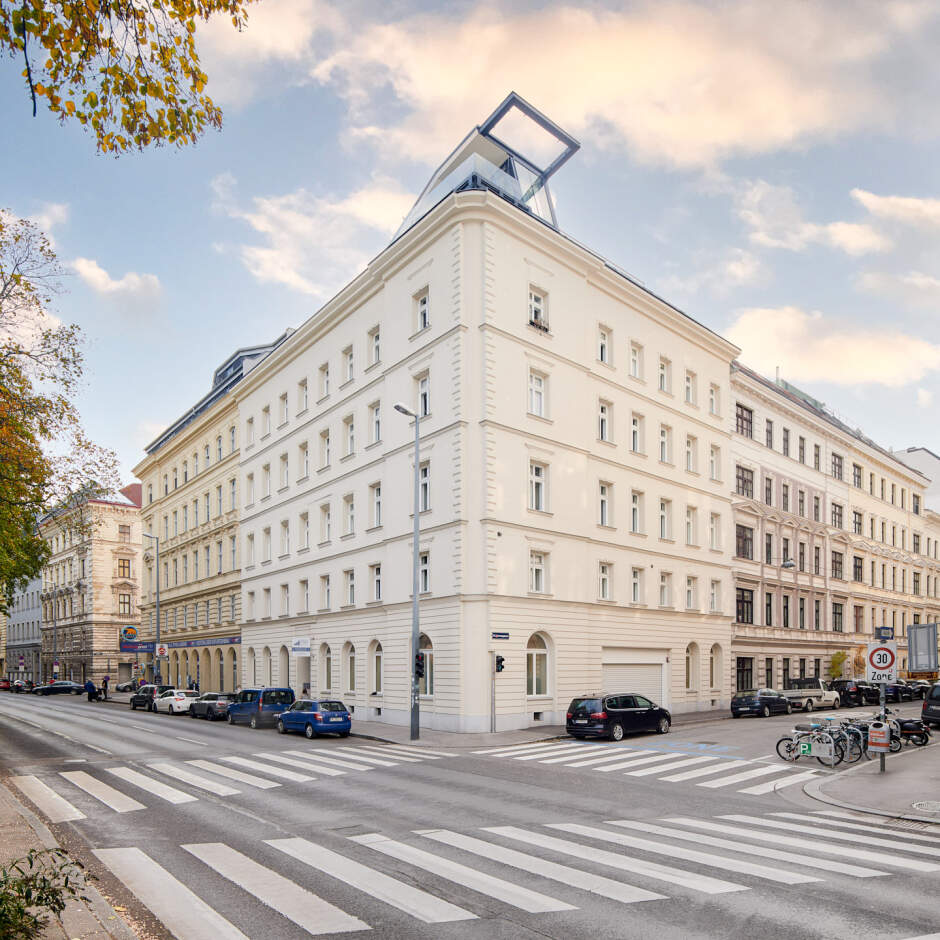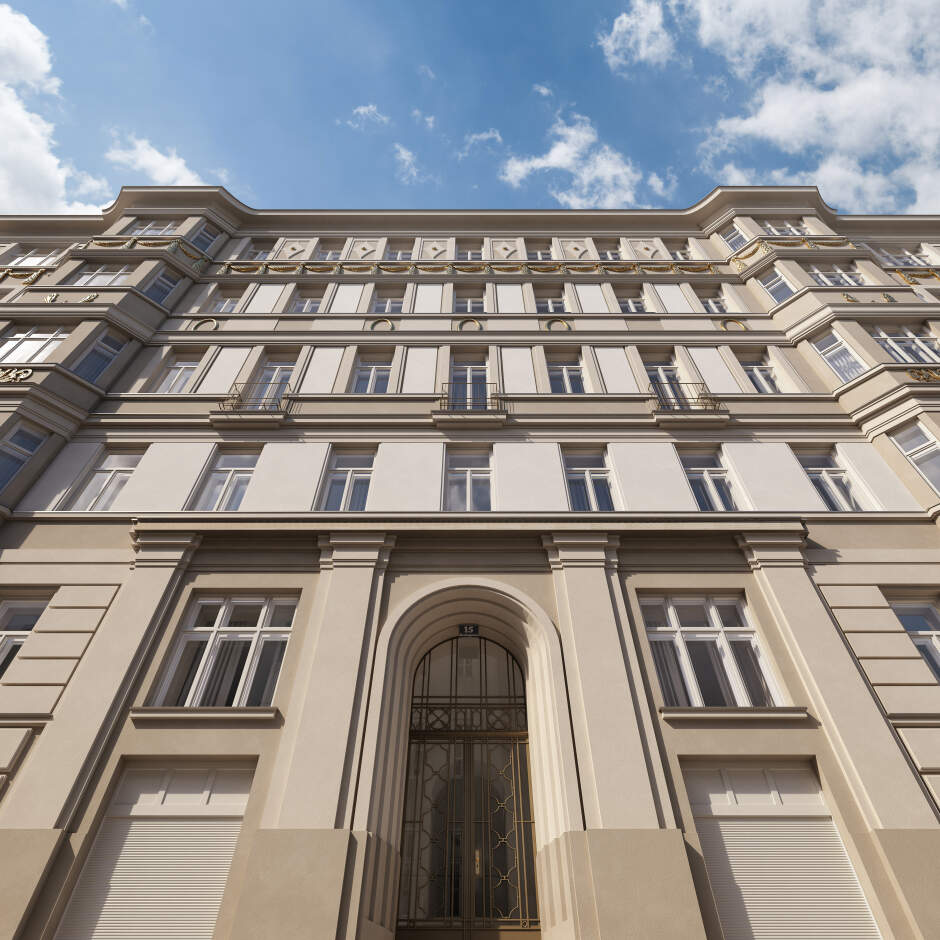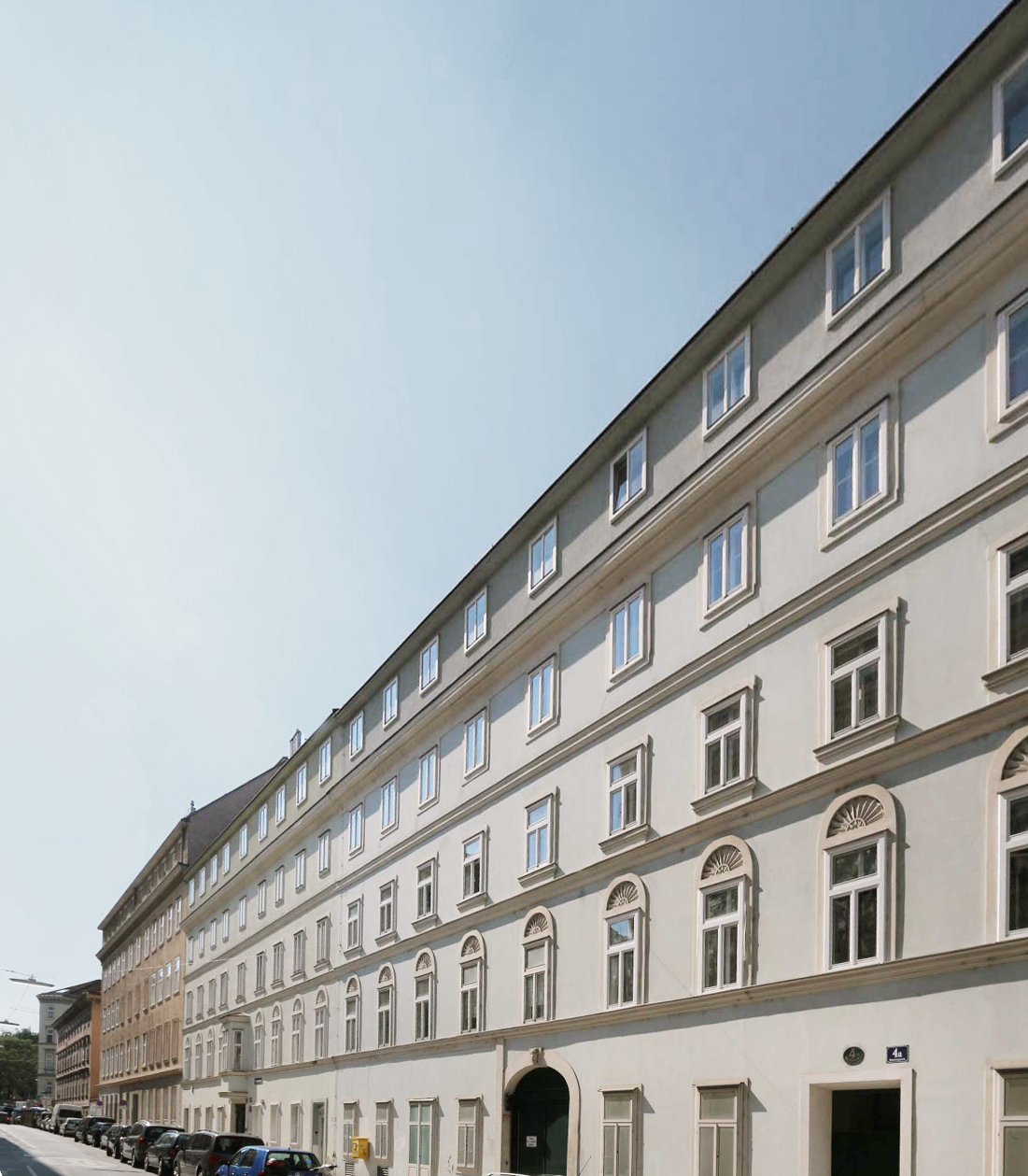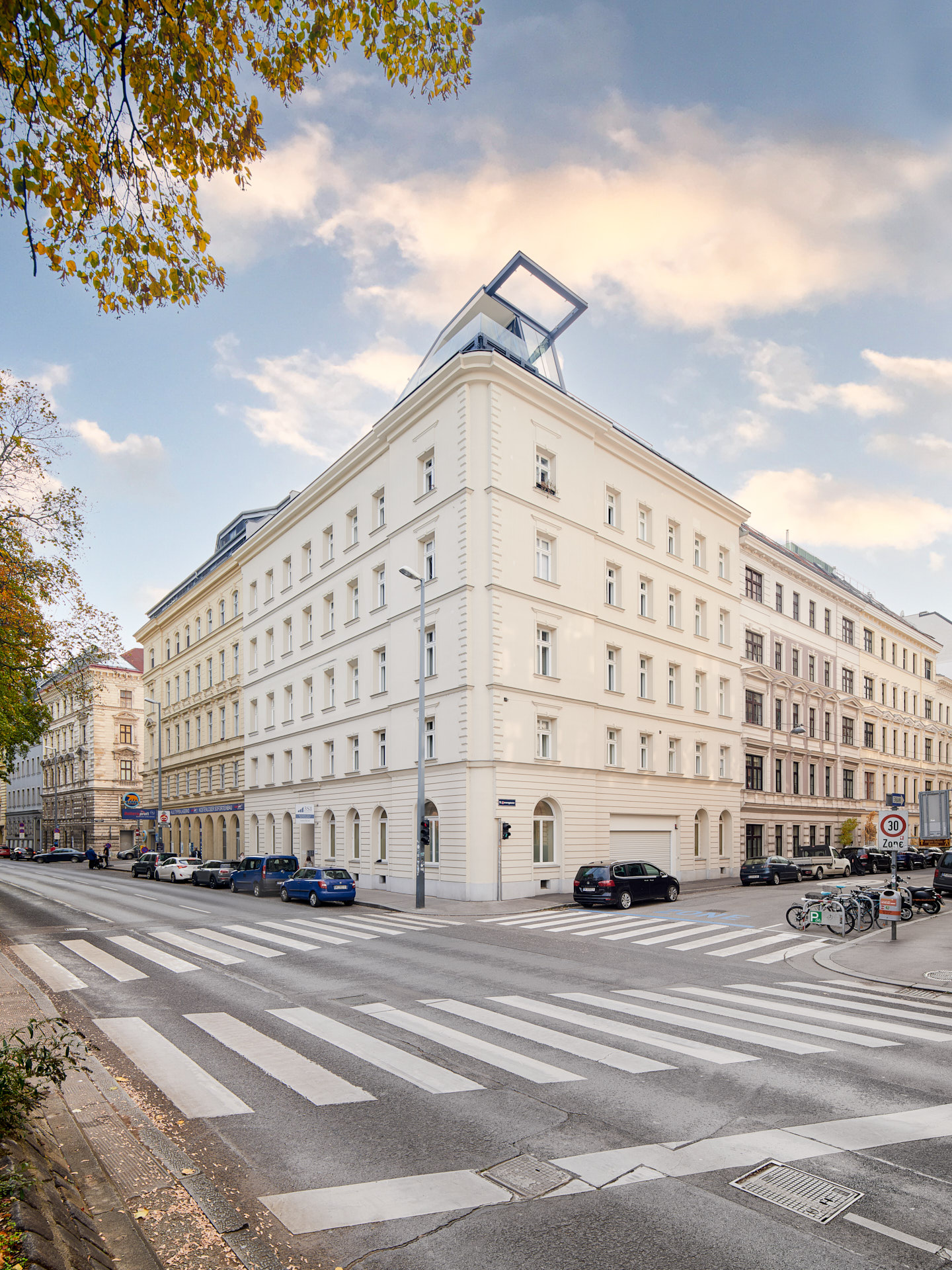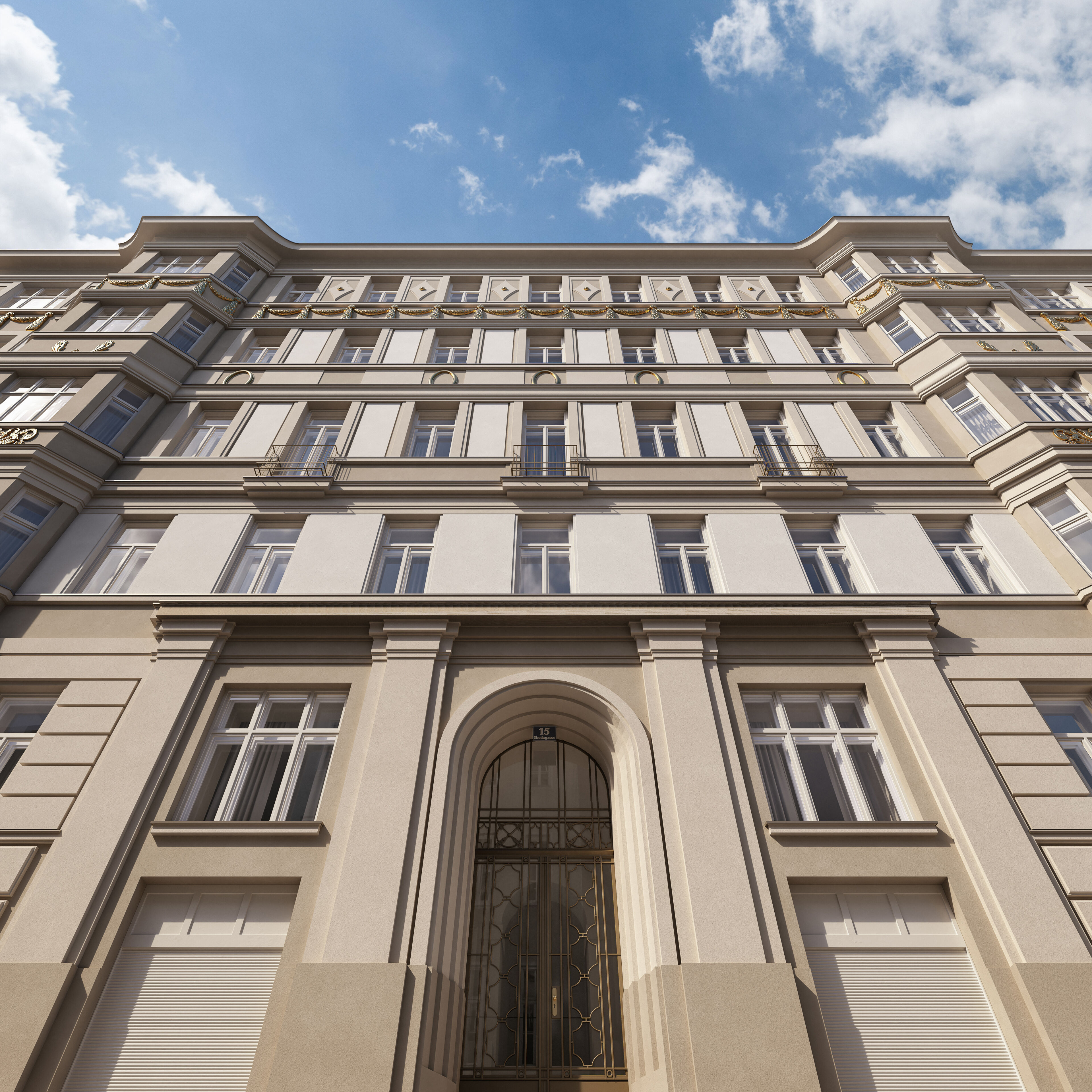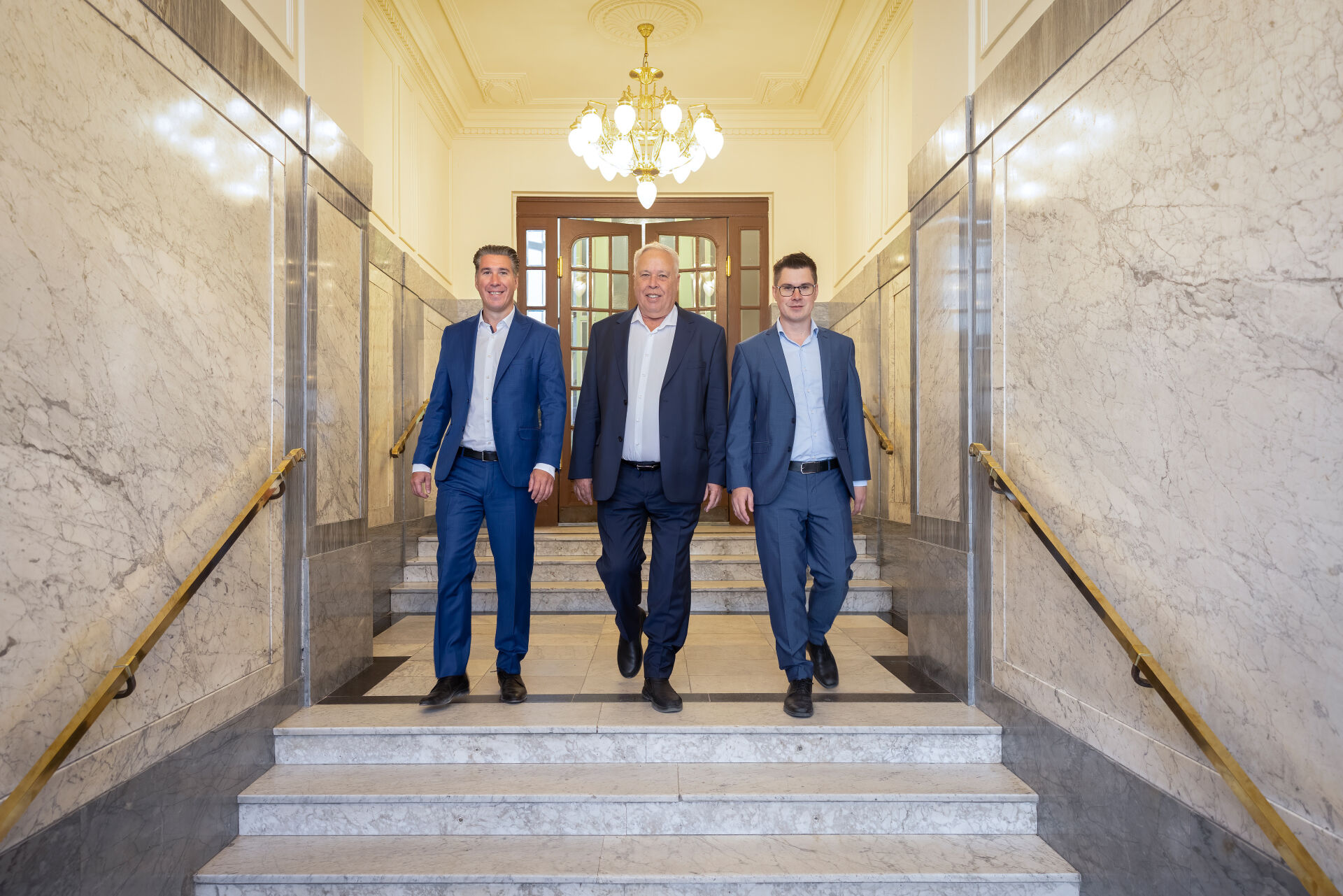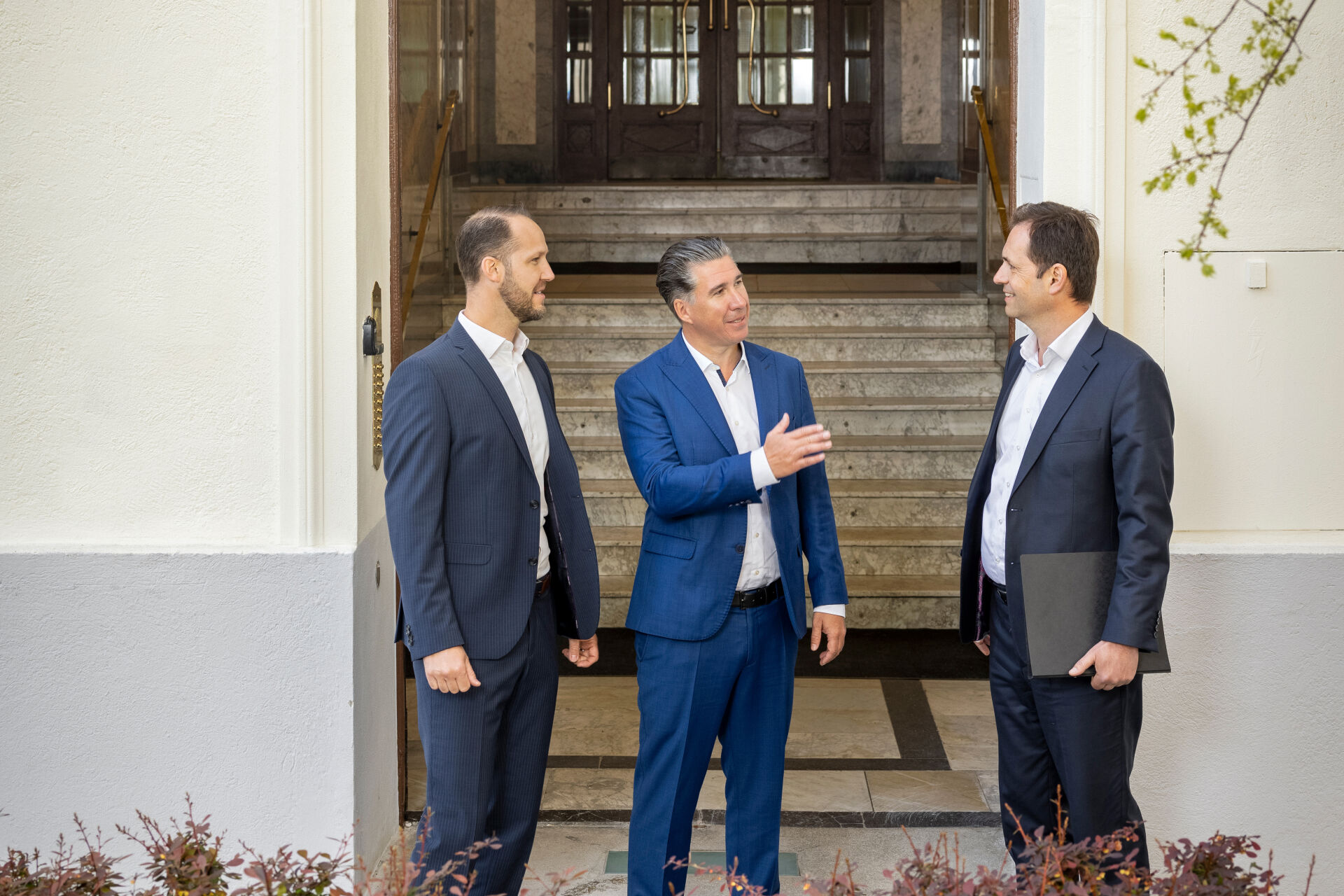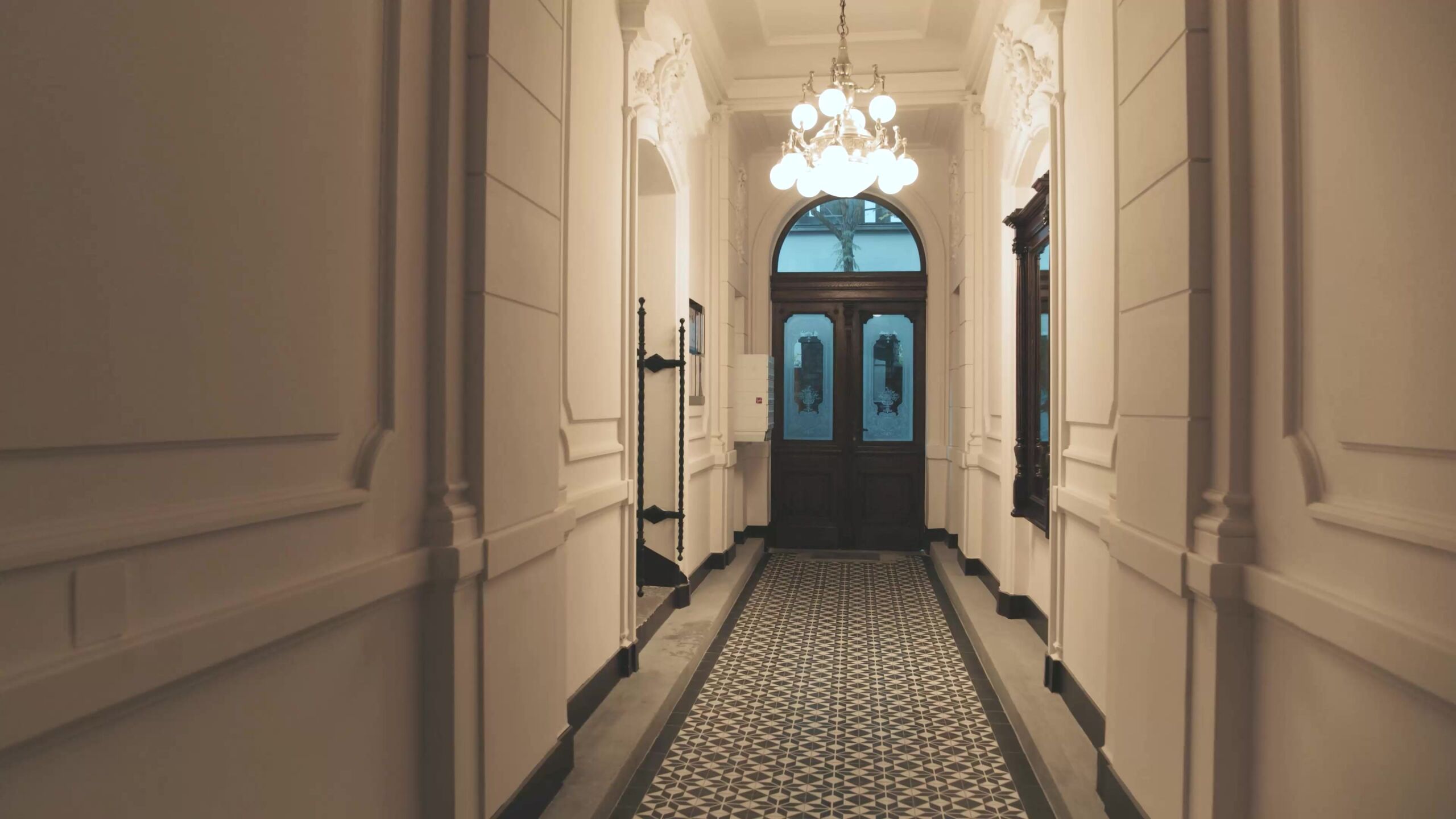
What is a “Zinshaus”?
The definition of the traditional Viennese apartment building
The Wilhelminian period, buoyed by the emerging upper middle class, was the era of Vienna’s development into an international metropolis. The period buildings in historicist style characterise the magnificent cityscape to this day. What all the apartment buildings have in common is their solid construction method and the superior quality of the materials used. High ceilings, double doors, and entrances decorated in stucco with magnificent cast iron railings are some of the characteristics that provide residents with first-class quality of life. The flair of a period apartment with its beautiful herringbone parquet floors, prominent box-type windows, and charming wood panelling on the walls and ceilings is still beyond comparison.
The structure of a Zinshaus
Explore the characteristic architectural features
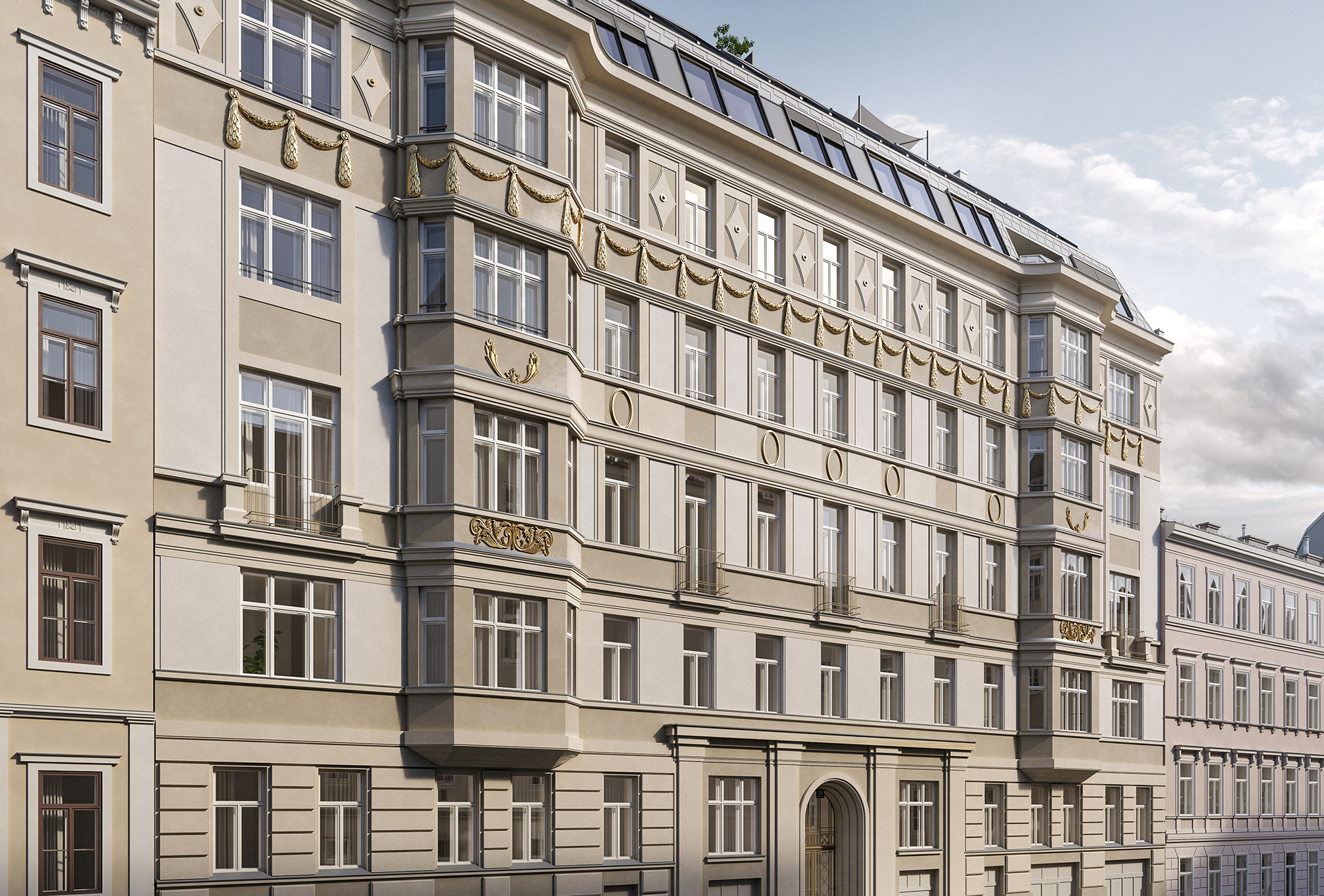
A traditional apartment building, or Zinshaus, usually has four to six floors and a decorated facade, some more elaborate than others, often with opulent stucco ornamentation. In order to circumvent tax regulations, mezzanines were used to reduce the number of floors on paper. Thus, by adding a souterrain (semi-basement) or a mezzanine (known in German as a Hochparterre, Mezzanin, or Halbstock, depending on the context), the actual number of floors was increased. These mezzanines are characterised by low ceilings and, sometimes, smaller areas than the full floors of an apartment building.
Discover the architectural details of a Viennese apartment building by taking a closer look at the individual elements of the facade in the picture to the right.
The different eras of the Zinshaus
The evolution of the Wilhelminian style building in Vienna
With a passion for period buildings
We will give your apartment building a secure future

From the magnificent facade to the charming interior to the unique existing structure – every apartment building has its own flair. The history of the building lends it a certain special appeal which can be felt in every corner. For decades we have been investing with passion in the renovation of apartment buildings and the stylish design of period apartments. We see it as our responsibility to preserve historic Wilhelminian apartment buildings for future generations and to maintain the beautiful cityscape of Vienna for eternity.
Are you planning on selling your apartment building?
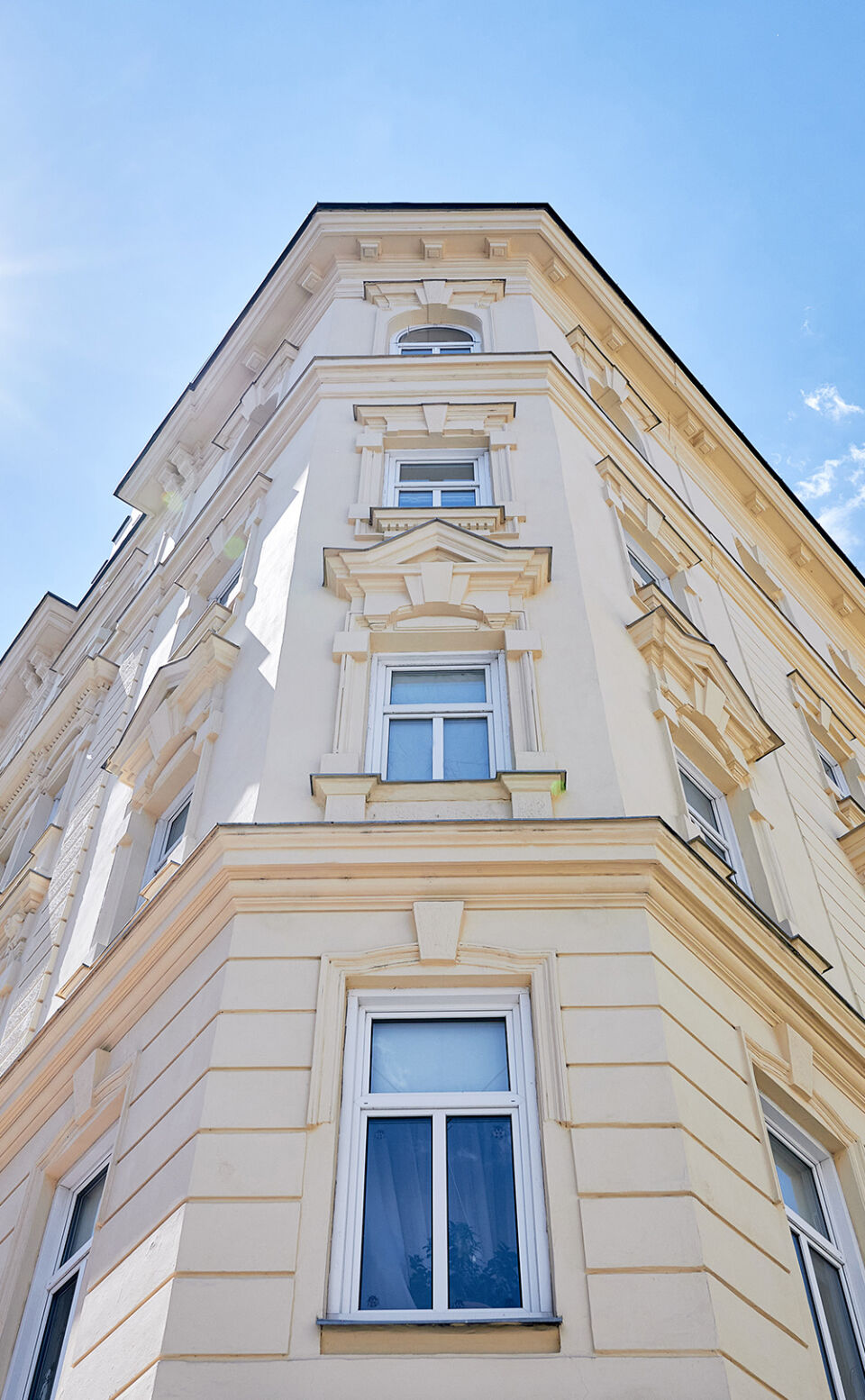
» A period building like a vintage car or good wine only gets better with age. «
Harald, Michael und Claus Schmidt
Do you have any further questions?
We have put together answers to the most frequently asked questions on the topic of Zinshäuser (i.e., historic apartment buildings)
-
What is a “Zinshaus”?
The word Zinshaus refers to a typically Austrian type of apartment building, most commonly found in Vienna. There are, however, Zinshäuser in other provincial capitals and urban areas, such as Graz, Linz, or Salzburg.
In its original meaning, Zinshaus refers, in Austria, to a building that was constructed prior to 1945. A Zinshaus is an apartment building consisting of several residential units which are let long-term for a monthly fee, i.e., the Zins or rent. It thus concerns older properties, some of which are even listed and were built solely for the purpose of earning rental income. That is why public buildings and town palaces are not referred to as Zinshäuser.
In today’s real estate industry, the term Zinshaus has increasingly come to refer to any building consisting of several apartments which are let for a monthly rent. Thus, the word Zinshaus is being used more and more frequently to refer to modern buildings as well. It should, however, be noted that this does not include subsidised housing complexes or cooperative apartments.
-
What does the word “Altbau” or “period building” mean?
An Altbau or period building refers to a residential building that was constructed prior to 1945. An Altbau is characterised by a specific architectural style which typically includes box-type windows, lavish facades, and high ceilings. This type of building also involves special rights for tenants and a cap (=benchmark rent) on rent prices.
-
How can I determine the value of an apartment building?
With the 3SI apartment building calculator, you can determine the value of your apartment building in just 9 quick and easy steps! The online calculation is a non-binding service offered free of charge by 3SI Immogroup to help you get an initial estimate of the potential purchase price of an apartment building. Check out the Zinshaus calculator for yourself!
-
How is the condition of an apartment building assessed?
It helps to have an expert on board if you want to check the condition of an apartment building. This expert can check the existing structure by conducting a condition assessment on the basis of construction documents and as-built drawings. In addition, a professional survey can provide clarity. This includes a close inspection and assessment of the stability of the foundation, the wear on wiring and pipes, the roof structure, and the condition of windows, doors, and stairs.
-
How much does it cost to renovate an entire apartment building?
Renovating an apartment building means improving the quality of the living space and thus increasing the value of the property as well. The renovation costs depend on the age of the building, the type and extent of potential damages, and the size of the area to be renovated. Besides the costs of labour and materials for the actual renovation work, you must also calculate the expenses for the planning stage and fees for construction experts or legal advice.
-
How much does it cost to renovate the facade of an apartment building?
Renovating the facade is not just about improving the appearance of the building but more importantly about enhancing the energy balance of the entire apartment building. Thermal renovation such as installing insulation and replacing windows reduces the energy costs and increases the value of the building. The renovation costs depend on the condition of the facade and the planned actions. Apartment building owners must reckon with at least €150 per m2.
-
Is my apartment building listed?
It is relatively easy to check online and see if your property is listed. The list of the Federal Monuments Authority Austria shows all the buildings protected in Austria. The list is updated once a year. In the case of immovable monuments such as properties or gardens, the listing is also entered in the land register.
Link: Denkmalliste des Bundesdenkmalamtes (only available in German) -
What do owners of listed apartment buildings need to be aware of?
Structural changes to listed buildings require a permit from the Federal Monuments Authority Austria. This includes changes to the existing structure as well as the outward appearance of the building. Apartment building owners are required to maintain their listed property. There are, however, numerous advantages for the owners of a listed apartment building, such as tax reliefs or a freer hand when it comes to setting rent prices (no cap).
-
What is the “Friedens(kronen)zins”?
The “peace rate” refers to the legally regulated rent in old rental contracts for business premises and apartments. On the basis of the rent agreed upon in Krone before the First World War, the “peace rate” for apartments is one Schilling (since 1951) and for business premises three Schillings (since 1969) per peace rate.
-
What is the “assessed value”?
The assessed value is the property value that is determined at extended intervals by the tax authorities. It is used as the basis to determine the various public taxes and duties. In the case of significant changes to the property’s value, for instance, due to renovations or additions, the assessed value must be redetermined.
-
What is the “usable floor area” of an apartment building?
The usable floor area of an apartment building is the area that can be used for a specific purpose. The usable floor area is calculated on the basis of the dimensions of the building and includes the entire floor space minus the walls.
In addition to the living spaces, the usable floor area also includes any loggias or parking spaces. Functional areas such as a boiler room or circulation areas such as stairs are not defined as usable floor area. The usable floor area is used to calculate the running costs and the rent and is generally essential for calculating the value of an apartment building.
-
How does the year of construction affect the value of an apartment building?
Apartment buildings that were built prior to 1945 are subject to the Tenancy Act. The rent of these apartments is thus, apart from a few exceptions, determined by the benchmark rent. For the owners of such apartment buildings, this usually means rental incomes far below the market value.
There are also restrictions in terms of the building for owners of older apartment buildings. Since an amendment of the Vienna Building Code in July 2018, apartment building owners require a permit from the municipal authorities before they can demolish their building. If the demolition of a dilapidated apartment building is not approved, the owners must either pay for a costly renovation or sell the building.
There are also restrictions on additions and extensions to listed apartment buildings. Apartment building owners must obtain a permit from the Federal Monuments Authority Austria if they want to make any structural changes to their building. This can, under certain circumstances, mean that a planned attic conversion is not approved, and the apartment building owner is thus deprived of additional rental income.
-
What is the “protected zone”?
The preservation order basically determines whether buildings in Vienna may be demolished, extended, or renovated. Since 1972, the City of Vienna can establish protected zones, regardless of the preservation order, to preserve the character of the city. They are primarily intended to protect the outward appearance of the building. The protected zones are shown in the land use and zoning plan.
The legal regulations for the demolition of an apartment building have changed due to an amendment of the Vienna Building Code in mid-2018. For properties built before 1 January 1945, the following applies: If the owners want to demolish their building, they must now obtain a permit from the municipal authorities. This applies even if the apartment building is dilapidated.
-
Is it also possible to sell individual shares of an apartment building?
In the case of simple co-ownership, each co-owner can freely dispose of their share. Co-owners can sell their share of the property without having to obtain the consent of the other co-owners. If a regulation of use has been recorded in the land register, this will be automatically passed on to the buyer.
If apartment ownership has already been established (partitioned) in the apartment building, the owner can also freely sell their share. It is different in the case of a property partnership. If a partner wants to sell their share, they must obtain the consent of the other partner. As an apartment building developer, we buy both shares as well as whole apartment buildings. Get in touch with us. We would be happy to advise you.
-
How much are the costs of building management?
Apartment building owners can freely negotiate the fees with the building management contractor. Most owners, however, base the fees on the “flat fee for administration expenses” (§ 22 Tenancy Act). This is currently (as of 1 May 2021) €3.60/m2 of usable floor area per year. Therefore, the fee for the building management of an apartment building with 1,000m2 of usable floor area would be €3,600 per year (excluding VAT).
-
How is the amount of rent determined?
The rent of an apartment is made up of the rent, running costs, and VAT. The amount of rent depends, among other things, on whether the apartment is subject to the Tenancy Act (MRG). The law provides clear benchmark rents for calculating the rent. For more on this, see “What is ‘benchmark rent?’” If the Tenancy Act does not apply, the landlord is entitled to collect a freely negotiated rent.
-
What is the difference between a fixed-term tenancy agreement and an indefinite tenancy agreement?
The main difference between fix-term and indefinite tenancy agreements is the length of tenancy. Indefinite tenancy agreements can be terminated by the landlord only in exceptional cases. For this to apply, the tenant must commit a gross violation, for instance, in the form of rent arrears or unauthorised subletting of the apartment. The landlord’s personal requirement exists only in the case of an acute housing shortage and courts usually decide in the favour of the tenant.
In the case of fixed-term agreements, the Tenancy Act requires a minimum fixed term of 3 years; there is no limit on the maximum duration. The agreement can be extended as often as desired, but the term of tenancy must always be at least 3 years. In the case of fixed-term agreements, tenants must be granted a 25% discount on the legally permissible rent. If the landlord does not wish to continue the fixed-term tenancy, the landlord must inform the tenant by registered mail. Otherwise, it can happen that the tenancy agreement is extended for an additional 3 years.
-
What is “benchmark rent”?
In the case of Viennese apartment buildings that were built prior to 1945 and are thus subject to the Tenancy Act, this is a cap on rent prices – the benchmark rent. The benchmark rent is set per m2 and is adjusted for inflation every two years on 1 April by a regulation of the Ministry of Justice. In addition, the location of the building or the furnishings of the apartment play a role in any surcharges or discounts, although there are no fixed rates for these by law.
The benchmark rent does not apply for buildings that were built after 1945 or residential units that have been newly created as part of an addition or renovation (attic conversion). The same applies for Category A and B apartments that are larger than 130 m2, Category D apartments, and apartments in listed buildings. -
What is “category rent”?
In many apartment buildings in Vienna, there are still old tenancy agreements with a category rent (tenancy agreement concluded before 1994). The amount of rent is determined by the respective category (A to D) and is adjusted according to the 1986 consumer price index. If inflation exceeds 5%, there will be a rent increase. In addition to category rent, tenants will be asked to pay a maintenance and improvement fee, the amount of which is also determined by law.
-
What is a “Category A apartment”?
A Category A apartment must be at least 30 m2 and have an anteroom, a room, a kitchen (or kitchenette), a toilet, and a contemporary bathroom (or bathing recess). The apartment must be heated either by a heat supply facility, a single-storey heating system, or an equivalent, stationary system.
-
What is a “substandard apartment”?
Substandard apartments mainly consist of a kitchen and a room (sometimes also a half-room) and have, depending on the category, a simple (Category C) or no water supply (Category D). In the case of Category D apartments, the toilet is located in the hallway. In Vienna, the stock of substandard apartments has declined significantly in recent years because many of these apartments have been renovated and merged together. Nowadays, substandard apartments play hardly any role in new tenancies.
-
What is the difference between a head lease and a sublease?
A principal tenant always concludes a tenancy agreement with the owner of the apartment or leaseholder/tenant of the entire building. If the principal tenant lets parts or the entire apartment to a third party, this is considered to be a sublease.
Generally, it is not permitted to sublet the apartment unless it takes place with the knowledge of the apartment owner or if only parts or individual rooms are sublet. If the tenancy between the principal tenant and the landlord is terminated, the sublease agreement is also terminated.
Contact
We look forward to seeing you!


